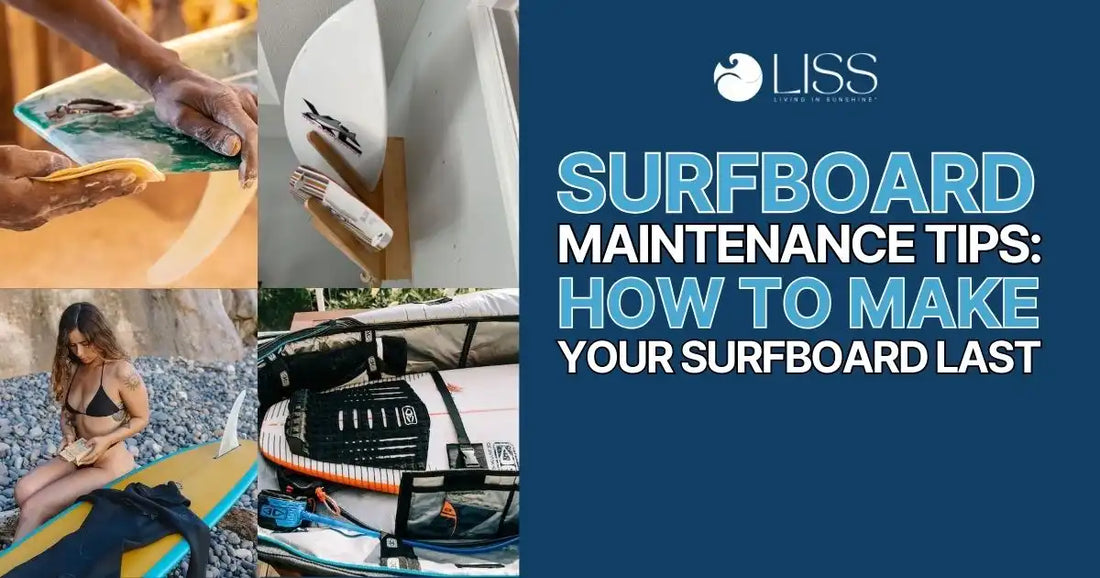
Surfboard Maintenance Tips: How to Make Your Surfboard Last
Share
To make your surfboard last, rinse it with fresh water after every session, store it in a cool, shaded area, repair dings right away, use a board bag, and limit sun exposure. Regular care helps your board perform well and extends its lifespan.
A surfboard isn’t cheap, and neither is the cost of constant repairs. Every ding, crack, or waterlogged foam core eats away at both its life expectancy and your bank balance. What should be quick sessions in the waves can easily turn into weeks of downtime and hundreds spent fixing damage that could have been prevented.
According to Surfacre, a trusted authority in board care and repair, fixing a broken board can cost $150 to $200 or more, while repairing delamination or similar damage typically runs between $100 and $140. For surfers, that means more time out of the water and more money out of pocket.
So, how can you keep your board in top shape and avoid costly repairs?
Why Surfboard Maintenance Matters?
Surfboards are exposed to harsh elements such as UV rays, saltwater, sand, pressure impacts, and physical wear from transport. Maintenance reduces damage, keeps the shape and flex consistent, and ensures every session is smooth and safe. Over time, the right care can save you money on repairs or replacements and keep your board performing like new.
13 Surfboard Maintenance Tips
Here are some of the surfboard maintenance tips that you should follow to keep your board in peak condition and avoid unnecessary repair costs:
1. Rinse Your Surfboard After Every Use

Saltwater accelerates the breakdown of foam and resin over time, so always rinse your board with fresh, clean water as soon as you finish your session. This removes salt, sand, and algae that can degrade your deck pad, wax, and materials. Use a soft cloth or sponge if sand is stuck to avoid scratching the surface.
If you want a quicker and more thorough clean, the Clean Fin makes it simple. This surfboard cleaner is designed to flush out trapped salt and sand from your fins and tail. It helps prevent buildup in those hard-to-reach spots, perfect for when you’re in a rush but still want to keep your board in top shape.
2. Avoid Leaving It in the Sun
Direct UV exposure can yellow the board’s surface, weaken the resin, and cause delamination, where the outer shell separates from the foam core. Sun damage is one of the main causes of long-term board wear. Store your board in a shaded area or use a reflective board sock or UV-resistant bag. Even draping a towel over your board can help reduce heat buildup during short breaks.
3. Always Use a Protective Board Bag
Scratches, dents, and pressure dings often occur during transport, not in the water. A quality board bag protects your board from impacts, sun, and even rain. Bags with padding and a reflective coating work best. If you travel often, consider a travel-specific bag with reinforced rails, fin slots, and shoulder straps for added convenience.
4. Check for Dings, Cracks, or Soft Spots After Every Surf
Tiny surfboard cracks can absorb water without showing visible signs immediately. Press gently around common damage areas such as the nose, tail, and rails. If any area feels soft or discoloured, the board may have internal damage. Look for hairline cracks near the fin boxes or tail, surface bubbling, or a board that feels heavier than normal.
5. Fix Dings Immediately (Never Surf with a Dinged Board)

Surfing with an open ding allows water to seep into the foam core, which can ruin your board from the inside. Even if it still “works,” you’re speeding up its deterioration. Use a ding repair kit for quick fixes, or take it to a professional shaper for larger or deeper damage. Always let the area dry completely before sealing it to prevent trapping moisture.
6. Store the Board Correctly at Home or in the Car

Avoid stacking boards directly on top of each other or placing them on hard surfaces without padding. Long-term pressure on a fin or rail can lead to warping or stress cracks. Instead, use padded wall racks, freestanding vertical racks, or a padded surfboard cradle, such as the durable and space-saving options in our Board Racks Collection. For long-term storage, remove the fins and keep the board in a dry, shaded, and well-ventilated space to preserve its shape and integrity.
7. Replace Your Wax Regularly

Wax collects grime over time and loses its grip, making it harder to maintain footing while surfing. Remove wax every two to three months, or more often in warm climates, using a wax comb and warm water. Keeping all your tools in one place makes the process easier, which is why the Wax Box is so useful.
This bamboo box features a sliding lid, a built-in comb and remover, plus two waterproof stickers. It keeps your wax tools protected and ready for when it’s time to strip off the old layer and apply a fresh base coat and topcoat suited to the current water temperature.
8. Protect and Maintain Your Fins
Fins affect how your board turns and holds a line. Damaged or misaligned fins can change how your board performs in the water. Always remove fins when flying. Use a fin key to check tightness before every session. Keep a spare fin or screw in your car or board bag, just in case.
9. Never Drag the Tail or Nose on Hard Surfaces

Dragging your board can wear down the tail, rail edges, or nose. Over time, this abrasion may expose the foam or wear through the glass coat. Carry your board under your arm or use a shoulder strap for long walks. If you need to lean it against something, place a towel under the tail to prevent scuffing.
10. Dry the Board Thoroughly Before Storing
Moisture trapped in fin boxes, cracks, or leash plugs can lead to mould or internal damage over time. After saltwater sessions, drying the board thoroughly helps prevent corrosion and salt build-up. Wipe it down with a clean towel, dry the leash, and check the fin boxes for any trapped water before storing.
11. Rotate Boards if You Own Multiple
Using one board continuously can cause faster wear in high-pressure areas. If you surf often, rotate between boards to distribute the wear and adapt to different wave conditions. This also helps preserve specialty boards, such as grovellers or guns, for specific wave types instead of wearing them out prematurely.
12. Avoid Extreme Temperature Swings
Rapid shifts from hot to cold, such as leaving a board in a hot car and then placing it in cold water, can cause expansion and contraction. This stresses the board’s materials and can lead to delamination. If your board has been stored in hot or cold environments, let it acclimatize gradually.
13. Be Mindful of Where You Surf and How You Fall
Shallow reef breaks, rocky points, and crowded lineups increase the risk of damage. Follow safe surfing etiquette and avoid falling onto your board, as this can cause pressure dings or snapped tails.
When to Replace or Retire Your Surfboard?
Even with proper care, surfboards have a limited lifespan. Signs that it might be time for a replacement include:
- Chronic waterlogging
- Major structural damage or delamination
- Reduced buoyancy or sluggish performance
- Warped shape or a soft deck
If your board still feels “off” despite multiple repairs, it may be time to invest in a new setup.
Care for Your Board, Care for Your Surf
A well-maintained surfboard saves money, preserves performance, and keeps you safe in the water. The difference between a board lasting five years or barely two often comes down to small habits: fixing dings early, keeping it out of the sun, and rinsing it after every session. Skipping these steps may seem harmless, but it can lead to costly repairs and lost time in the waves. Maintenance isn’t optional—it’s an investment in your skills and your connection with the ocean. Treat your board well, and it will remain a reliable partner for many seasons.
At Living in Sunshine, we offer a premium Surfboard Racks & Surf Accessories Collection designed to make board care effortless. Made with sustainably sourced materials, backed by a one-year warranty, and supported by a 90-day money-back guarantee, our products keep your board in peak condition so you can spend more time chasing waves and less time worrying about wear and tear.
FAQs
How often should I wax my surfboard?
For the best grip and performance, add a light top-up of wax before each surf session. Over time, old wax can lose its stickiness, so fully strip and re-wax your board every 2–3 months—about 4–6 times a year—depending on water temperature and how often you surf. Regular waxing ensures your feet stay secure and your board responds the way it should in the water.
What type of surfboard lasts the longest?
Epoxy surfboards generally last longer than traditional polyurethane (PU) boards because epoxy resin is more resistant to dings, UV damage, and water absorption. With proper care, an epoxy board can last over 10 years, while a PU board may show wear within 5–7 years. However, longevity still depends on usage frequency, storage, and maintenance habits.
How can I protect my surfboard while traveling?
When traveling, use a padded travel bag with reinforced rails and nose protection. Wrap the tail, fins, and rails with bubble wrap or foam padding, and remove fins to prevent pressure cracks. Avoid stacking heavy items on top of the board during transport, especially on flights. For extra protection, add a layer of clothes or towels inside the bag to absorb impact.
What is the best way to store surfboards in long-term?
For long-term storage, keep your board in a cool, dry space with good ventilation. Place it on a padded rack to prevent pressure dings, remove fins, and cover it with a breathable board bag (avoid plastic wrapping, which can trap moisture). Check it every few weeks for signs of mold, warping, or pest damage.

